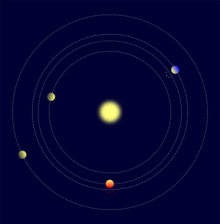Kepler-223
| Observation data EpochJ2000.0EquinoxJ2000.0 | |
|---|---|
| Constellation | Cygnus |
| Right ascension | 19h53m16.4202s[1] |
| Declination | +47° 16′ 46.308″[1] |
| Characteristics | |
| Apparent magnitude(g) | 15.903[2] |
| Apparent magnitude(r) | 15.301[2] |
| Apparent magnitude(i) | 15.105[2] |
| Apparent magnitude(z) | 14.963[2] |
| Apparent magnitude(D51) | 15.667[2] |
| Apparent magnitude(J) | 14.095[2] |
| Apparent magnitude(H) | 13.727[2] |
| Apparent magnitude(K) | 13.632[2] |
| J−Kcolor index | 0.463[2] |
| Characteristics | |
| Spectral type | G[3] |
| Astrometry | |
| Proper motion(μ) | RA:−4.227(25)mas/yr[1] Dec.:−11.094(24)mas/yr[1] |
| Parallax(π) | 0.5005 ± 0.0215mas[1] |
| Distance | 6,500 ± 300ly (2,000 ± 90pc) |
| Details | |
| Radius | 1.095[2]R☉ |
| Surface gravity(logg) | 4.386[2]cgs |
| Temperature | 5,599[2]K |
| Metallicity | -0.211[2] |
| Other designations | |
| Database references | |
| SIMBAD | data |
| KIC | data |


Kepler-223(KOI-730,KIC10227020) is a G5V star with anextrasolarplanetary systemdiscovered by theKepler mission.Studies indicate that the Kepler-223star systemconsists of 4planetsorbitingthestar.[5][3]
Planetary system
[edit]| Companion (in order from star) |
Mass | Semimajor axis (AU) |
Orbital period (days) |
Eccentricity | Inclination | Radius |
|---|---|---|---|---|---|---|
| b | — | — | 7.3845 | — | — | 3R🜨 |
| c | — | — | 9.8456 | — | — | 3.4R🜨 |
| d | — | — | 14.7887 | — | — | 5.2R🜨 |
| e | — | — | 19.7257 | — | — | 4.6R🜨 |
The confirmed planetary system was first detected by the Kepler mission, and contains four planets.[6]This system was initially believed to contain twoco-orbital planetsorbiting the star at approximately the sameorbital distanceevery 9.8 days, with one permanently locked 60° behind the other in one of the twoTrojanLagrangian points.[7]The two co-orbital planets were thought to be locked inmean motion resonanceswith the other two planets, creating an overall 6:4:4:3 resonance.[8]This would have been the first known example of co-orbital planets.
However, follow-up study of the system revealed that an alternative configuration, with the four planets having orbital periods in the ratio 8:6:4:3 is better supported by the data. This configuration does not contain co-orbital planets,[9]and has been confirmed by further observations.[3]It represents the first confirmed 4-bodyorbital resonance.[6]
The radii are 3.0, 3.4, 5.2, and 4.6 Earth radii, and the orbital periods are 7.3845, 9.8456, 14.7887 and 19.7257 days, respectively.[3]
See also
[edit]References
[edit]- ^abcdVallenari, A.; et al. (Gaia collaboration) (2023)."GaiaData Release 3. Summary of the content and survey properties ".Astronomy and Astrophysics.674:A1.arXiv:2208.00211.Bibcode:2023A&A...674A...1G.doi:10.1051/0004-6361/202243940.S2CID244398875. Gaia DR3 record for this sourceatVizieR.
- ^abcdefghijklm "KIC10 Search".Multimission Archive at STScI.8 October 2009.Retrieved5 March2011.
- ^abcdMills, S. M.; Fabrycky, D. C.; Migaszewski, C.; Ford, E. B.; Petigura, E.; Isaacson, H. (11 May 2016). "A resonant chain of four transiting, sub-Neptune planets".Nature.533(7604): 509–512.arXiv:1612.07376.Bibcode:2016Natur.533..509M.doi:10.1038/nature17445.PMID27225123.S2CID205248546.
- ^"Kepler-223".SIMBAD.Centre de données astronomiques de Strasbourg.Retrieved22 August2020.
- ^Borucki, William J.; Koch, David G.; Basri, Gibor; Batalha, Natalie; Brown, Timothy M.; Bryson, Stephen T.; Caldwell, Douglas; Christensen-Dalsgaard, Jørgen; Cochran, William D.; Devore, Edna; Dunham, Edward W.; Gautier, Thomas N.; Geary, John C.; Gilliland, Ronald; Gould, Alan; Howell, Steve B.; Jenkins, Jon M.; Latham, David W.; Lissauer, Jack J.; Marcy, Geoffrey W.; Rowe, Jason; Sasselov, Dimitar; Boss, Alan; Charbonneau, David; Ciardi, David; Doyle, Laurance; Dupree, Andrea K.; Ford, Eric B.; Fortney, Jonathan; et al. (2011). "Characteristics of planetary candidates observed by Kepler, II: Analysis of the first four months of data".The Astrophysical Journal.736(1): 19.arXiv:1102.0541.Bibcode:2011ApJ...736...19B.doi:10.1088/0004-637X/736/1/19.S2CID15233153.
- ^abKoppes, S. (17 May 2016)."Kepler-223 System: Clues to Planetary Migration".Jet Propulsion Lab.Retrieved18 May2016.
- ^Chown, Marcus (28 February 2011)."Two planets found sharing one orbit".New Scientist.
- ^Emspak, Jesse (2 March 2011)."Kepler Finds Bizarre Systems".International Business Times.International Business Times Inc.
- ^Beatty, Kelly (5 March 2011)."Kepler Finds Planets in Tight Dance".Sky and Telescope.
External links
[edit]- "Planetary System KOI-730 Exhibiting a Pair of Co-Orbital Planets"(this site requires a browser with support forWebGL)
- 2MASSCatalogRetrieval
